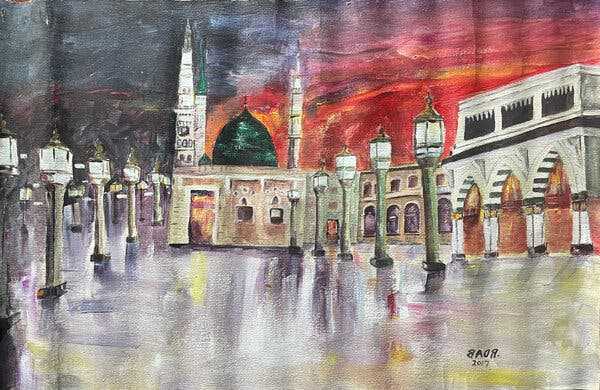The Trump administration called detainee art U.S. government property and halted most releases. Lawyers never mounted an intellectual property case.
-
Send any friend a story
As a subscriber, you have “>10 gift articles to give each month. Anyone can read what you share.
Give this articleGive this articleGive this article

The prisoner Mohammed Ahmed Ghulam Rabbani painted this scene at Guantánamo Bay and gave it to a lawyer before the Trump administration banned all such releases in 2017. Mr. Rabbani, who is one of 20 prisoners eligible for transfer, wants to take with him all the paintings he has at the prison when he is repatriated to Pakistan.

By Carol Rosenberg
Feb. 7, 2023, 11:05 a.m. ET
The Defense Department has lifted the Trump administration’s ban on the release of artwork made by prisoners at Guantánamo Bay, in a recent policy change that allows departing detainees to take their work with them.
Under the new policy, detainees are allowed to take “a practicable quantity of their art” when they leave Guantánamo Bay, Lt. Col. Cesar H. Santiago, a Pentagon spokesman, said by email.
He declined to define “practicable quantity” but said the Defense Department still considers the artwork to be “the property of the U.S. government.”
Colonel Santiago also declined to say when the new policy was adopted.
The prison imposed the ban in late 2017, after an art exhibit in New York called “Ode to the Sea” struck a nerve at the Pentagon. It featured seascapes, model ships and other works by current and former Guantánamo detainees, and its website offered an email address for people “interested in purchasing art from these artists.”
The Defense Department, for the first time, declared the artwork government property. A spokesman said officials “were not previously aware that detainee artwork was being sold to third parties.”
More on U.S. Armed Forces
- Lobbying Saves Flawed Ships: The Navy pushed to retire nine of its newest warships, after years of crippling problems and a changing mission. But then the lobbying started.
- R.O.T.C. Programs: After The Times reported that some high schools were automatically placing freshmen into the military-sponsored programs at public high schools, congressional leaders are expanding their scrutiny of the military’s Junior Reserve Officers’ Training Corps program.
- Korean War Wall of Remembrance: Many names of American service members who died in the conflict are misspelled or missing from the new memorial wall in Washington, relatives and researchers say.
- Parental Leave: The Pentagon announced a new policy that would double the amount of leave that is available to military service members.
Before that, the prison had permitted lawyers for the detainees to take their clients’ art off the U.S. Navy base — after a security screening that analyzed it for secret messages with national security implications. In the instance of some model ships made by a Yemeni, troops went so far as to make and study an X-ray of it. Some detainees transferred off the base had also been allowed until then to bring their works of art with them.
Defense lawyers protested the ban but never mounted an intellectual property challenge in federal court to resolve it.
How Times reporters cover politics. We rely on our journalists to be independent observers. So while Times staff members may vote, they are not allowed to endorse or campaign for candidates or political causes. This includes participating in marches or rallies in support of a movement or giving money to, or raising money for, any political candidate or election cause.
Learn more about our process.
The Pentagon’s concession comes at an important moment. Of the 34 men who are currently held at Guantánamo, 20 have been cleared for transfer with security arrangements. None of them have been charged with a crime. Among them are many men who spent their later years in custody painting, drawing and creating sculptures, some in art classes with one ankle shackled to the floor. Some have amassed huge collections of their work.
Last year, the dispute over the art caught the interest of two rapporteurs for the United Nations — one focusing on human rights, the other on cultural rights — who wrote a letter to Secretary of State Antony J. Blinken inquiring about the policy.
They specifically mentioned five prison artists among the 20 who had been approved for transfer, calling them “victims” of “what seems to be disproportionate restrictions of the exercise of freedom of artistic expression.”
One is a Pakistani prisoner, Mohammed Ahmed Ghulam Rabbani, 53, who has been approved for repatriation. The other four are Yemenis who have no place to go because Congress forbids repatriations to their war-torn homeland, which is too unstable to safely resettle and monitor detainees.
The Biden administration has not yet replied to U.N. officials. But one of the rapporteurs, Fionnuala Ní Aoláin, is visiting the detention operation at Guantánamo this week. The topic of artwork is expected to be discussed.
The Biden administration has been reviving efforts to transfer cleared detainees with security arrangements and has so far repatriated or freed six men. The most recent prisoner to be released, Majid Khan, who is resettling in Belize, said the only art he brought with him was 46 pages of poetry, which had been approved for release by the military.
The Trump administration released only one man, Ahmed Haza al-Darbi, and the military sent his artwork with him when he was transferred to a Saudi prison in 2018. The former chief prosecutor for military commissions, Brig. Gen. Mark S. Martins, obtained the exception for Mr. Darbi’s art because he had served as a cooperating witness against other war court defendants.
For years, before the ban, the prison featured detainee artwork during tours of Guantánamo’s detention facilities by reporters and other delegations. Journalists were encouraged to photograph it. Once the ban was imposed, reporters were no longer allowed to view the artwork.
Source: nytimes.com



